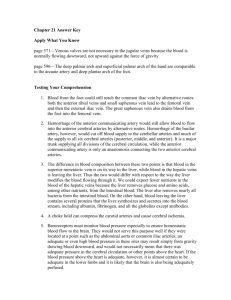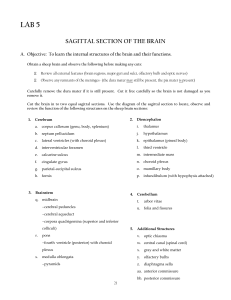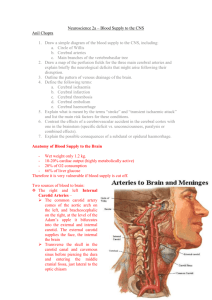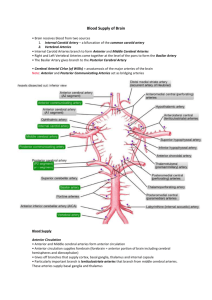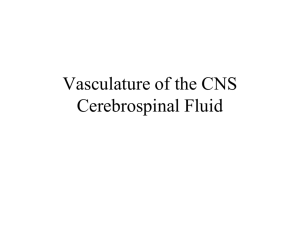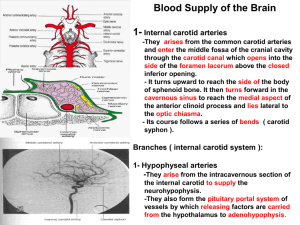Nolte – Chapter 6 (Blood Supply of the Brain)
advertisement
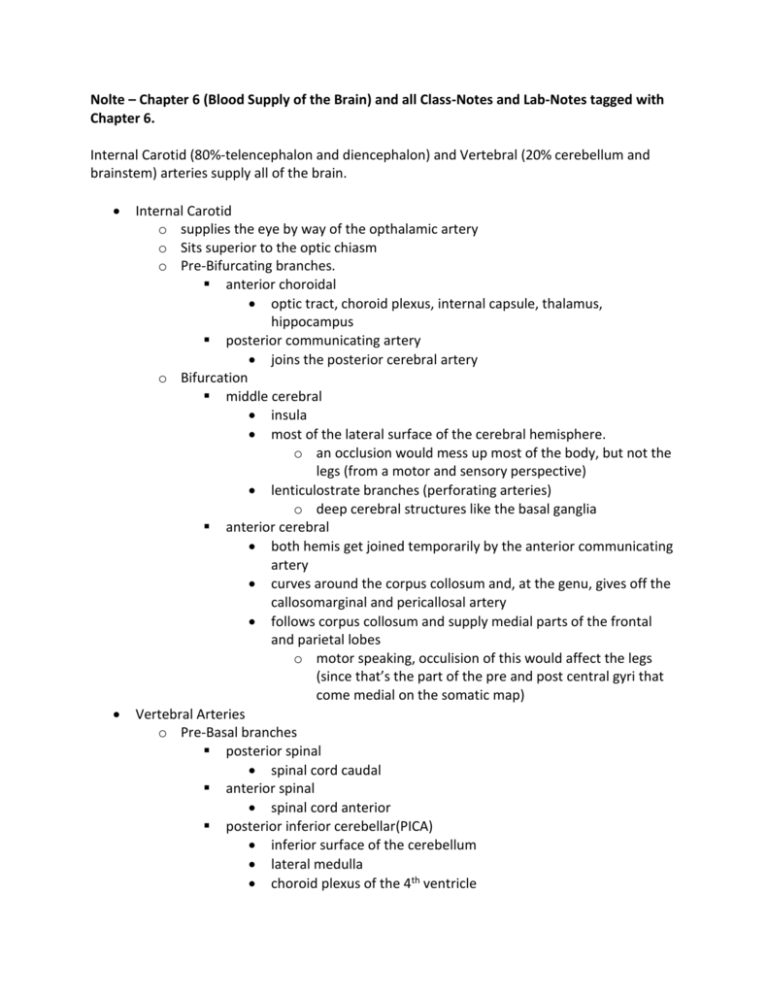
Nolte – Chapter 6 (Blood Supply of the Brain) and all Class-Notes and Lab-Notes tagged with Chapter 6. Internal Carotid (80%-telencephalon and diencephalon) and Vertebral (20% cerebellum and brainstem) arteries supply all of the brain. Internal Carotid o supplies the eye by way of the opthalamic artery o Sits superior to the optic chiasm o Pre-Bifurcating branches. anterior choroidal optic tract, choroid plexus, internal capsule, thalamus, hippocampus posterior communicating artery joins the posterior cerebral artery o Bifurcation middle cerebral insula most of the lateral surface of the cerebral hemisphere. o an occlusion would mess up most of the body, but not the legs (from a motor and sensory perspective) lenticulostrate branches (perforating arteries) o deep cerebral structures like the basal ganglia anterior cerebral both hemis get joined temporarily by the anterior communicating artery curves around the corpus collosum and, at the genu, gives off the callosomarginal and pericallosal artery follows corpus collosum and supply medial parts of the frontal and parietal lobes o motor speaking, occulision of this would affect the legs (since that’s the part of the pre and post central gyri that come medial on the somatic map) Vertebral Arteries o Pre-Basal branches posterior spinal spinal cord caudal anterior spinal spinal cord anterior posterior inferior cerebellar(PICA) inferior surface of the cerebellum lateral medulla choroid plexus of the 4th ventricle o Two vertebral combine into the Basilar Artery Prebifurcation anterior inferior cerebellar(AICA) o anterior portions of the inferior surface of the cerebellum(flocculus) o caudal pons superior cerebellar o superior surface of cerebellum o rostral pons and caudal midbrain Bifurcation posterior cerebral arteries o this get an extra fuel from the internal corotid’s posterior communicating artery. o supply medial and inferior surfaces of the occipital and temporal lobes would lead to visual field losses Circle of Willis o posterior cerebral artery is connected to the internal carotid by the posterior communicating o the anterior communicating(connecting the two anterior cerebral at a junction) finishes the circle. o if one major vessel becomes occluded either within the circle of Willis or proximal to it, the communicating arteries may allow critically important anastomotic flow and prevent neurological damage Blood Vessel o innermost is the luma, then internal elastic lamina, then smooth muscle, then adventitia layer Blood Flow o autoregulation act to maintain constant flow vessels will constrict(increase resistance) in response to increased blood pressure they relax in response to decreased pressure. o indicative of increased synaptic activity, which causes the release of glutamate that then reaches nearby astrocyte end-feet which can then release vasodilating factors (prostaglandins and NO). Injuries o necrotic region is known as an infarct o ischemic strokes a thrombus(blood clot) and an embolus(foreigh matter- part of a blood clot or plaque) causes an occlusion of an artery supplying the brain. if near circle of willis, adequare collateral circulation can happen. if not…less likely o tiny lesions are lacunes o profound iscemial repifly depletes the energy stores of neurons and they depolarize and release excitatory neurotransmitters in a destructive cascade usually is surrounded by a penumbra (shodow region) o intracerebral hemorrhage is a type of stroke that is the rupture of small perforating arteries such as the lenticulostriate (part of the middle cerebral) o aneurysms balloon like swellings of arterial walls can push against brain regions like a tumor. can cause a subarachnoide hemorrhage if they rupture o arteriovenous malformation large anastomoses between arteries and veins and steal blood from normal tissue The Blood Brain Barrier o extracellular fluid of the body to the extracellular fluid of the brain o includes the arachnoid barrier layer and the blood-CSF barrier o also includes the true blood-brain barrier tight junctions between adjacent endothelial cells of cerebral capillaries together with a lack of pinocytotic o lipid soluble substance can diffuse across and glucose can cross it by a process of facilitated diffusion. o substances can be actively transported across this endothelial wall. o pituitary gland can freely interact with the blood like the choroid plexus o Other regions can monitor the composition of extracellular flui and project axons Veins o cerebral veins empty into the dural venous sinuses and lead into the interal jugular veins and into the basilar venous plexus this communicates with the epidural venous plexus. o Veins are either superficial or deep superficial are on the surface of the hemispheres and empty into the superior saggital sinus uperficial middle cerebral runs along the lateral sulcus and drains the temporal lobe superior anastomotic vein travels across parietal and connects the middle with the superior sagittal sinus. inferior anastomotic vein is the posterior and inferior temporal love deep veins drain internal sutrctures and empty into the straight sinus. internal cerebral vein drains the thalamus and caudate o its branch the thalmostriate is joined by the choroidal vein which drains the choroid plexus o internal cerebral veins bend sharply at a “Venous angle” at the location of the interventricular foramen o The great vein takes the internal cerebral veinsthrough the transverse cerebral fissure in the superior cistern and goes to form the straight sinus. its also joined by the basal veins which is formed near the optic chiasm and gets joined by the deep middle cerebral vein that drains the insula.
